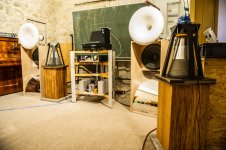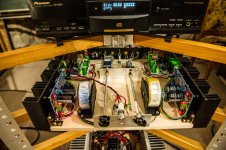Also, AS. I want to see if I could get Joachim hooked to the idea of how far could one push the single-supply, single-ended concept.
The technician in me also like the symmetric and nice concept. But, is it good or just visual nice for the technician?
Cheers,
Mogens
You can do single ended without coupling caps, but need a split supply.
Hi guys,
AS, but not with DC wall plug surely?
Thanks Joachim, I have a "back of the napkin" drawing here too. But, how could could it actually be made? 🙂 that's my thinking?
Also, Joachim. check out the girl in my link. If only the general hifi enthusiast has as much happiness towards music.
Cheers,
Mogens
AS, but not with DC wall plug surely?
Thanks Joachim, I have a "back of the napkin" drawing here too. But, how could could it actually be made? 🙂 that's my thinking?
Also, Joachim. check out the girl in my link. If only the general hifi enthusiast has as much happiness towards music.
Cheers,
Mogens
Hi AS,
Sorry, for not being clear. Just a standard wall-plug which provides DC voltage. I have a few here. Actually, I haven't got many AC ones, beside the ones I have made so.
Cheers,
Mogens
Sorry, for not being clear. Just a standard wall-plug which provides DC voltage. I have a few here. Actually, I haven't got many AC ones, beside the ones I have made so.
Cheers,
Mogens
I have not seen a dc wall outlet in my life.
AC mains is common here for 70+ years..
Edison would be happy with it.
AC mains is common here for 70+ years..
Edison would be happy with it.
Hi AS,
I see the confusion. A langue barrier on my part perhaps?
Wall-plug == transformer or even switch mode PSU that plugs directly into the wall-plug.
Sorry for the confusion,
Mogens
I see the confusion. A langue barrier on my part perhaps?
Wall-plug == transformer or even switch mode PSU that plugs directly into the wall-plug.
Sorry for the confusion,
Mogens
Seems I was right in the first place.Hi AS,
I see the confusion. A langue barrier on my part perhaps?
Wall-plug == transformer or even switch mode PSU that plugs directly into the wall-plug.
Sorry for the confusion,
Mogens
So if you plug a transformer in the ac wall outlet anyway, why don't you chose one which fits the need?
The price of it is considerably less than the price of the RIAA.
Hi AS,
Sorry if I misunderstood you. What I was thinking of was a generic one which could be had with all approvements and build in a black block. Perhaps I'm not expressing myself properly. Sorry about that.
I would like to use something generic that had all the approvements so I could sleep well if my sons friends build an RIAA here and took it home and plugged it in.
Cheers,
Mogens
Sorry if I misunderstood you. What I was thinking of was a generic one which could be had with all approvements and build in a black block. Perhaps I'm not expressing myself properly. Sorry about that.
I would like to use something generic that had all the approvements so I could sleep well if my sons friends build an RIAA here and took it home and plugged it in.
Cheers,
Mogens
This circuit uses a wallwart as i call it :http://nixiekits.eu/Downloads/SPA_Aufbauanleitung.pdf
They squeeze out more voltage with a cascade ( voltage doubler... ).
There is even a tube in there.
I build it for fun and it works.
They squeeze out more voltage with a cascade ( voltage doubler... ).
There is even a tube in there.
I build it for fun and it works.
I really NEED a high power amp.
It is not my forte though.
I designed a Class A amp that is said to sound good.
It has some Class A/B leverage upwards.
It is not my forte though.
I designed a Class A amp that is said to sound good.
It has some Class A/B leverage upwards.
Both, amp and preamp, use Lateral fets at the output, output from the drains and not the sources.
The output impedance is low ( not very ) due to current feedback from the output.
This amps are not so much about low distortion but they are stable on any capacitive load and have high speed into the MegaHerz.
This amps are not so much about low distortion but they are stable on any capacitive load and have high speed into the MegaHerz.
I succeeded to make a lineamp out of circuit post 10013 with the help of AS and Frans.
Offset is trimable and stable plus-minus 1mV.
This without any matching or thermal coupling, good.
In this case lowest offset also brings lowest distortion.
I learned from Scott Wurzer that this is a good thing.
More information soon.
Offset is trimable and stable plus-minus 1mV.
This without any matching or thermal coupling, good.
In this case lowest offset also brings lowest distortion.
I learned from Scott Wurzer that this is a good thing.
More information soon.

